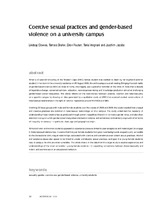| dc.contributor.author | Clowes, Lindsay | |
| dc.contributor.author | Shefer, Tamara | |
| dc.contributor.author | Fouten, Elron | |
| dc.contributor.author | Vergnani, Tania | |
| dc.contributor.author | Jacobs, Joachim | |
| dc.date.accessioned | 2013-09-20T14:13:01Z | |
| dc.date.available | 2013-09-20T14:13:01Z | |
| dc.date.issued | 2009 | |
| dc.identifier.citation | Clowes, L.et al.(2009). Coercive sexual practices and gender-based violence on a university campus. Agenda: Empowering women for gender equity, 80: 22-32 | en_US |
| dc.identifier.issn | 1013-0950 | |
| dc.identifier.uri | http://hdl.handle.net/10566/724 | |
| dc.description.abstract | When a 22-year-old University of the Western Cape (UWC) female student was stabbed to death by her boyfriend (another
student) in her room in the university residence on 25 August 2008, the entire campus was left reeling. Bringing the stark reality
of gender-based violence (GBV) so close to home, the tragedy was a powerful reminder of the limits of more than a decade
of legislative change, concerted activism, education, consciousness-raising and knowledge production aimed at challenging
gender-based power inequalities. This article reflects on the relationships between violence, coercion and heterosexuality
on a specific campus by drawing on data generated by a qualitative study at UWC that explored student constructions of
heterosexual relationships in the light of national imperatives around HIV/AIDS and GBV.
Involving 20 focus groups with male and female students over the course of 2008 and 2009, the study revealed that unequal
and coercive practices are common in heterosexual relationships on this campus. The study underlined the necessity of
understanding these relationships as produced through power inequalities inherent in normative gender roles, and also drew
attention to ways in which gender power inequalities intersect in complex and sometimes contradictory ways with other forms
of inequality on campus – in particular, class, age and geographical origin.
While both men and women students appeared to experience pressure (linked to peer acceptance and material gain) to engage
in (hetero)sexual relationships, it seems that first-year female students from poor, rural backgrounds are particularly vulnerable
to the transactional and unequal relationships associated with coercive and sometimes even violent sexual practices. Alcohol
and substance abuse also appear to be linked to unsafe and abusive sexual practices, and again it is young female students
new to campus life who are most vulnerable. This article draws on the data from this larger study to explore experiences and understandings of the most vulnerable – young female students – in unpacking connections between (hetero)sexuality and violent and coercive sex in an educational institution. | en_US |
| dc.language.iso | en | en_US |
| dc.publisher | Taylor & Francis, co-published with Unisa Press | en_US |
| dc.rights | Copyright Taylor & Francis, with Unisa Press. Permission granted to reproduce the journal article in this Repository. | |
| dc.source.uri | http://dx.doi.org/10.1080/10130950.2009.9676236 | |
| dc.subject | Sexuality | en_US |
| dc.subject | Gender | en_US |
| dc.subject | Coercive sex | en_US |
| dc.subject | Gender-based violence | en_US |
| dc.subject | university students | en_US |
| dc.title | Coercive sexual practices and gender-based violence on a university campus | en_US |
| dc.type | Article | en_US |
| dc.privacy.showsubmitter | false | |
| dc.status.ispeerreviewed | true | |
| dc.description.accreditation | International Bibliography of Social Sciences | en_US |

